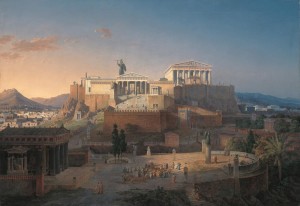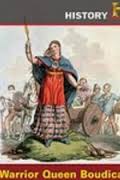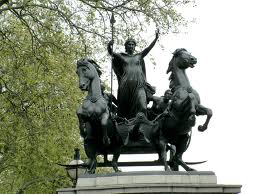For those of you who’ve read a few of my previous posts you know that I’m a bit of a history nerd. I’m not formally trained in any way, no degree or even a minor. It’s just something that has always interested me. I was the kind of kid who would go to look something up in Funk & Wagnalls – for the young, that’s a heavy leather bound set of books that came out semi-annually from 1912 to 1997. Oddly enough in the 1960s and 70s grocery stores sold them one book at a time for a dollar or two. I don’t remember if our set came directly from the local A&P or if my parents bought it at a garage sale or something.
In any event, I would crack open the ‘A’ volume looking for Alligator or Albatross or whatever and never get to it. Somewhere along the way I’d always find something else that caught my eye, maybe Athens or Assyria. If I had the time, I might even look up related subjects, like Sparta or Persia. As I said, I was a bit of a nerd.
 I’ve also mentioned in several interviews that I became an author, at least in part, because of my children, especially my daughter. All of my children love to read. If you’re ever invited to one of their birthday parties and don’t know what to get them, you can’t go wrong with an Amazon or Barnes & Noble gift card. They circle their calendars for the latest releases from their favorite authors.
I’ve also mentioned in several interviews that I became an author, at least in part, because of my children, especially my daughter. All of my children love to read. If you’re ever invited to one of their birthday parties and don’t know what to get them, you can’t go wrong with an Amazon or Barnes & Noble gift card. They circle their calendars for the latest releases from their favorite authors.
As I covered in an earlier blog Female leads, while many of their favorites include female characters, they’re often in a supporting not a lead role. There’s an old adage in the publishing industry that girls will read boys books, but not vice versa. I think that belief greatly influences what the traditional houses choose to publish. I understand that. They’re businesses and their goal is to make money. One of my goals in the Misaligned series is to challenge that adage and write a book with a girl lead that girls and boys will read.
S o what’s that got to do with history? I also wanted to integrate history into the series. I probably should’ve written a historical fiction story, but to be honest as a fan of Cornwell and Pressfield, I thought that would be a bit much for me. Instead, I chose to integrate history into a fantasy story. Like many other authors, I use ancient history, myth, and in my case a bit of String Theory, as the foundation for the fantastic events in the Misaligned series. I also use school projects as a way to directly integrate the kids in the story with history. I do my best to include both men and women. The first book includes references to Matilda Joslyn Gage, a supporter of women’s rights and the Underground Railroad, while the second includes Boudica and Hatshepsut.
o what’s that got to do with history? I also wanted to integrate history into the series. I probably should’ve written a historical fiction story, but to be honest as a fan of Cornwell and Pressfield, I thought that would be a bit much for me. Instead, I chose to integrate history into a fantasy story. Like many other authors, I use ancient history, myth, and in my case a bit of String Theory, as the foundation for the fantastic events in the Misaligned series. I also use school projects as a way to directly integrate the kids in the story with history. I do my best to include both men and women. The first book includes references to Matilda Joslyn Gage, a supporter of women’s rights and the Underground Railroad, while the second includes Boudica and Hatshepsut.
 Here’s an excerpt from the just released second book, Misaligned: The Silver Scepter, featuring Boudica the Iceni leader who rebelled against the Romans (I took some writer’s license here and connected the Iceni, who were from East Anglia, more closely to Wales than history suggests, but other than that it’s accurate):
Here’s an excerpt from the just released second book, Misaligned: The Silver Scepter, featuring Boudica the Iceni leader who rebelled against the Romans (I took some writer’s license here and connected the Iceni, who were from East Anglia, more closely to Wales than history suggests, but other than that it’s accurate):
Mr. Myrdin looked to Master Poe, who raised and lowered his wings in his approximation of a shrug; Mr. Myrdin nodded his head before continuing, “While we didn’t meet the Coch Coblyn until the fifteenth century, I’ve been able to trace tales of him back to Roman Britain. Unlike the Celts of Ireland and Scotland, who successfully maintained their independence from Rome, their brothers in Wales and Cornwall weren’t so fortunate. According to the myths, the Coch Coblyn was a powerful faerie summoned by Celtic druids at the request of Boudica to help her overthrow the hated Romans.”
“Why’s he called a red leprechaun?” asked Duncan. “Aren’t leprechauns those short tricksters who wear green and hide their pots of gold at the end of rainbows? When Mr. Myrdin nodded, Duncan continued, “I don’t get how a small practical joker could help defeat the Romans? I mean, what’s he going to do… tickle them to death?”
Mr. Myrdin smiled and shook his head. “His name is actually a bit of a misnomer. You see, the Coch Coblyn is not a true Leprechaun; he merely resembles one. He’s short, bearded, and has overly large feet, much like a true Leprechaun, but that’s where the similarity ends. While true Leprechauns are a friendly, albeit slightly mischievous, weaker type of Bodach, the Coch Coblyn is an altogether different character.”
Duncan scowled back at Mr. Myrdin, who silently retorted with a sardonic smile. After a few moments, Mr. Myrdin continued, “He wears red because it is the color of blood and battle and the Coch Coblyn was summoned to help the Celts fight.”
“But the Celts lost, didn’t they?” Penny asked.
“Yes, but initially they were quite successful,” answered Mr. Myrdin. “With the Coch Coblyn’s help, Boudica led the Celts to victory over the Romans in three great battles. Goaded on by the Coch Coblyn and their desire to wreak revenge on their Roman overlords, the Celts not only defeated the Roman army, they devastated the towns that later became Colchester, London, and St. Albans. They slew everyone they found in the cities and burned them to the ground.”
“Even the children?” asked Penny.
“Women, children, young and old, it made no difference. They were infused with the bloodlust of the Coch Coblyn. People retold the tale of the slaughter for years. Even three centuries later, when I was born, my Master Druid told the story of Boudica’s battles as a warning against cooperating too closely with powerful Bodach.”
“I can see why,” said Duncan.
“Yes, unfortunately, Boudica didn’t have the benefit of that lesson. Too late, she realized the evil of her bargain with the Coch Coblyn. Revolted at watching her own daughters participate in the wanton slaughter, she attempted to revoke her covenant with him.”
“Attempted?” Duncan asked.
“Yes, pacts with extra-dimensional beings are never easy to escape. In return for her life, the Coch Coblyn agreed to free her people from his bloodlust. She died thinking she’d saved her people.”
“The Coch Coblyn didn’t keep his end of the deal?” asked Duncan, aghast.
“On the contrary, he kept it to the letter. In the next battle, he remained neutral. Valiant as the Celts were, without the help of the Coch Coblyn, they were no match for the reinforced and well-trained Romans. They were slaughtered and Wales was absorbed into the empire.”
As always thanks for reading.
Armen
More Information
Please visit my website for more information on the Misaligned series


Great post, Armen. I agree about boys not reading female protag books. I have found I get a good audience of boys with my MG novel because my girl is a real tomboy and solves ghostly legends. And her sidekick is a strong boy character. Love historical stuff too, and I too put a lot of that in my books. The kids are learning without realizing it. Keep up the good work.
Rita, you’re right, one of my goals is to encourage an interest in history. My female lead (Penny) isn’t a tomboy, but she’s a good swimmer and also the smartest kid in school. Her sidekick, Duncan, isn’t threatened by her abilities or that she’s smarter than him. He’s a very good swimmer and his support is critical to their success.
Reblogged this on Library of Erana and commented:
History in fiction is never wasted.
We are definitely cut from the same cloth! Thanks for sharing.
A lot of fantasy is medieval style, or dark ages. Do the research, make the world a world which is real, research the weapons, the lifestyle, even the history of individuals can provide good information to adapt.
I couldn’t agree more – it’s actually on my list for upcoming blog topics. My forthcoming series, The Warders, is set in a typical high fantasy world with a medieval-like society and technology. I spent many hours researching minor aspects of that time period. Quite a few chapters take place on a ship and there’s a naval battle – again a lot of research for what many might think are minor details.
Yes. I have been crafty and not mentioned ships much, although the MMC has a…privateer in book one so I did have to do a bit of research. There will be a inland city traded by canals so I need to research that, plus old fashioned pottery making. I am NOT even going to comprehend a naval battle for a while. If you find any useful sources please feel free to share!
I may well do a blog post about research at some point soon. Outside of the fantasy genre it can be important too. Historical fiction tends to be read by people who like fiction and they WILL notice if your period piece has the wrong information.
With Sci fi, you can have some leeway but even then, gravity is gravity. Even the fantastic has to be plausible.
I actually had some basic knowledge of ships, at least the types I wanted to use, which enabled me to follow a google trail until I found the info I needed. As for the naval battle, I read several accounts of naval warfare in the middle ages and earlier. Fortunately, my story wasn’t a straight battle, but an attempt by one crew to board and capture the other ship, so that allowed me to focus on just two ships.
Awesome cover! What a great way to celebrate breaking top 100. Congratulations.
Thanks Misty. I’ll pass your comment on to Laura. I’m sure she’ll appreciate it.
I love the cover. It is fabulous!!! Congrats on breaking the top 100!!! Wow!!!! The giveaway is a fun idea!!!! 🙂
Thanks Brenda. My cover artist is Laura Redmond, she’s easy to work with and does great work.
Wonderful blog, great giveaway. Congrats Armen.
Thanks Lynelle. I’m just trying to figure this whole thing out, one mistake at a time.